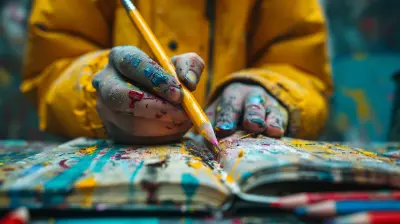Encouraging Creativity Through Songwriting
20 October 2025
Creativity is like a muscle—the more you use it, the stronger it gets. And one of the best ways to flex that creative muscle? Songwriting. Whether you're a seasoned musician or just someone who loves to hum melodies in the shower, songwriting is a powerful tool for self-expression, emotional release, and artistic growth.
But let’s be honest—getting started can feel intimidating. Where do you even begin? How do you turn thoughts and feelings into lyrics and melodies? And most importantly, how do you encourage creativity in the songwriting process?
That’s exactly what we’re going to dive into. Whether you’re writing your first song or your hundredth, this guide will help you unlock creativity, overcome writer’s block, and craft songs that truly resonate.

Why Songwriting Sparks Creativity
Before we get into the "how," let’s talk about the "why." Songwriting isn't just about making music—it exercises multiple parts of your brain at once.- It blends logic and emotion – Your left brain (logic and structure) works on rhyme schemes, rhythm, and song structure, while your right brain (creativity and emotion) brings in storytelling, metaphors, and melodies.
- It encourages free expression – Unlike essays or formal writing, songwriting gives you total creative freedom. Want to write about a talking cat on a spaceship? Go for it.
- It breaks mental barriers – Many people don’t consider themselves "creative," but songwriting proves that everyone has a unique story and voice to share.
Now that we know why songwriting fuels creativity, let’s break down how to nurture that creativity in your own process.

Embracing the Creative Process
Creativity isn’t something you can force—it’s something you invite. Here are some ways to open the door to inspiration.1. Let Go of Perfectionism
One of the biggest creativity killers? Perfectionism. That little voice in your head that says, “This isn’t good enough” or “No one will like this.”Here’s the truth: your first draft will never be perfect, and that’s okay. Even the greatest songwriters write bad songs before they write good ones. Instead of aiming for perfection, aim for progress. Write freely, without judgment, and refine later.
2. Keep a Songwriting Journal
Ideas are sneaky little things—they tend to show up when you least expect them. Keeping a songwriting journal (or using a notes app on your phone) helps capture inspiration in the moment.Write down:
- Random thoughts
- Interesting phrases
- Personal experiences
- Dreams or emotions
- Even overheard conversations!
You never know when a tiny idea will grow into a full song.
3. Play with Prompts
Staring at a blank page can be intimidating. If you’re feeling stuck, try using prompts to jumpstart creativity.Here are a few to get you started:
- Write a song about a childhood memory.
- Describe a place using only emotions.
- Pick a random object in the room and write a song about it.
- Imagine you’re writing a letter to your past self.
Prompts remove the pressure of coming up with something "original" and instead encourage exploration.
4. Collaborate with Others
Creativity thrives in connection. Working with other songwriters, musicians, or even poets can introduce fresh ideas and new perspectives.Co-writing sessions help with:
- Expanding lyrical themes
- Exploring different melodies
- Getting feedback in real-time
Plus, bouncing ideas off someone else can make the process more fun and less frustrating.

Breaking Through Writer’s Block
Everyone—yes, everyone—experiences writer’s block at some point. When creativity feels stuck, these tricks can help you push through.1. Change Your Environment
Sometimes, a simple change of scenery works wonders. If you always write in the same spot, try moving to a park, coffee shop, or even a different room. A new environment can spark fresh inspiration.2. Write Every Day (Even If It’s Bad)
Waiting for inspiration to strike? Bad news—it’s unreliable. Creativity works like a muscle, and the more you use it, the stronger it gets. Set aside just 10 minutes a day to write something—anything.Even if you write something terrible, you’re still flexing your creative muscle. Over time, great ideas will start to emerge naturally.
3. Experiment with Different Styles
Ever tried writing in a genre outside your comfort zone? If you usually write pop songs, try country. If you love rock, experiment with jazz. Pushing boundaries forces your brain to think differently, leading to unexpected and exciting results.4. Take a Break and Listen to New Music
If you’re stuck, step away from your work. Listen to a playlist of songs you wouldn’t normally hear. Pay attention to the lyrics, structures, and melodies—what resonates with you? Inspiration often strikes when you’re least expecting it.
Structuring Your Song
While creativity thrives in freedom, having a structured approach can help shape raw ideas into a strong, meaningful song.1. Start with a Core Emotion or Message
Every great song has a central theme or emotion. Ask yourself:- What do I want to express?
- How do I want the listener to feel?
- What story am I trying to tell?
Keeping a clear focus prevents the song from feeling scattered.
2. Follow a Basic Song Structure
You don’t have to stick to the rules, but understanding basic song structures can make writing easier. A common format is:Verse 1 → Introduces the story or theme
Chorus → The main message or emotional peak
Verse 2 → Expands on the story
Bridge → A shift in perspective or climax
Chorus → Reinforces the central theme
Understanding how songs flow gives you a roadmap to guide your creativity.
3. Use Vivid Imagery and Metaphors
Great lyrics go beyond telling—they paint pictures in the listener’s mind. Instead of saying, "I feel sad," describe how sadness feels.For example:
- Instead of “I’m lonely” → “My room is an empty echo”
- Instead of “I miss you” → “Your laughter still lingers in the morning air”
Specific imagery makes songs more relatable and emotional.
4. Play with Melody and Rhythm
Lyrics are important, but the way they sound matters just as much. Try singing your lyrics in different rhythms and melodies until something clicks. Sometimes, the right melody can bring a song to life in ways words alone cannot.Final Thoughts
Encouraging creativity through songwriting is about letting go of fear and embracing the process. There will be days where you write something amazing, and days where nothing makes sense—but every step is part of the journey.So grab a notebook, pick up an instrument (or just your voice), and start writing. Don’t wait for creativity to knock—invite it in. You’ll be amazed at what you create.
all images in this post were generated using AI tools
Category:
Music EducationAuthor:

Eva Barker
Discussion
rate this article
1 comments
Lana McKeehan
What a fascinating approach! Exploring songwriting as a tool for creativity opens up endless possibilities for self-expression and emotional growth. I’m eager to learn how these techniques can be applied in various educational settings!
October 31, 2025 at 3:57 AM


